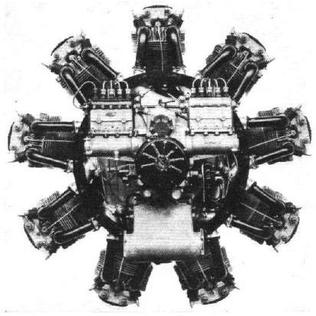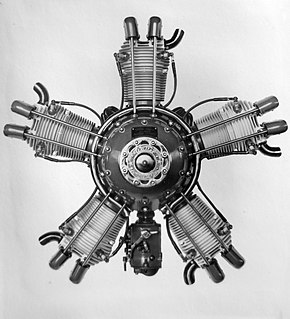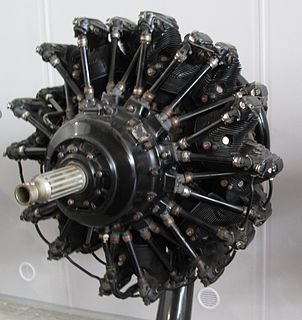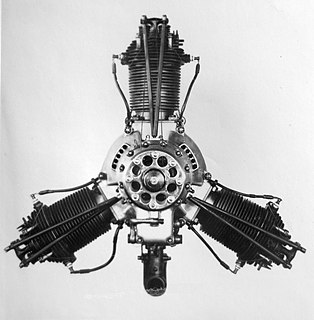
The Bristol Jupiter was a British nine-cylinder single-row piston radial engine built by the Bristol Aeroplane Company. Originally designed late in World War I and known as the Cosmos Jupiter, a lengthy series of upgrades and developments turned it into one of the finest engines of its era.

The Phoenix was an experimental version of the Bristol Aeroplane Company's Pegasus engine, adapted to run on the Diesel cycle. Only a few were built between 1928 and 1932, although samples fitted to a Westland Wapiti held the altitude record for diesel-powered aircraft at 27,453 ft from 11 May 1934 until World War II. The primary advantage of the Phoenix was better fuel efficiency at cruise, by up to 35%.

The Armstrong Siddeley Mongoose is a British five-cylinder radial aero engine produced by Armstrong Siddeley. Developed in the mid-1920s it was used in the Hawker Tomtit trainer and Parnall Peto seaplane amongst others. With a displacement of 540 cubic inches (9 litres) the Mongoose had a maximum power output of 155 horsepower (115 kilowatts).

The Walter Venus was a seven-cylinder, air-cooled, radial engine for aircraft use, built in Czechoslovakia in the late 1920s.

The Walter Vega was a five-cylinder, air-cooled, radial engine for aircraft use, built in Czechoslovakia in the late 1920s.

The Wolseley Aries III or A.R.9 was a British nine-cylinder, air-cooled radial aero engine that first ran in 1933, it was designed and built by Wolseley Motors. Intended for the military trainer aircraft market few were produced as Wolseley withdrew from the aero engine market in 1936.

British Salmson aero-engines refers to a series of small French designed, air-cooled radial aero engine that were produced by British Salmson, under license from Société des Moteurs Salmson, in Great Britain during the late 1920s and 1930s.

The Walter Scolar was a Czechoslovakian nine-cylinder, air-cooled radial engine for powering light aircraft that first ran in 1936. With a displacement of 8 litres, it produced 132 kW at 2,500 rpm.

The Walter Pollux is a Czechoslovakian nine-cylinder, air-cooled, radial engine, built by Walter Aircraft Engines for powering light aircraft and that first ran in 1936. The engine produces 240 kW (320 hp) at 1,800 rpm.

The Walter Regulus was a Czechoslovakian five-cylinder, air-cooled radial engine for powering light aircraft that first ran in 1934. The engine produced 186 kW.

The Walter Polaris was a Czechoslovakian three-cylinder, air-cooled radial engine for powering light aircraft that was developed in the 1930s.

The Walter Bora was a Czechoslovakian nine-cylinder, air-cooled radial engine for powering light aircraft that was developed in the 1930s by Walter Aircraft Engines.

The Walter Mars was a Czechoslovakian 14-cylinder, air-cooled radial engine for powering aircraft, a licensed built Gnome-Rhône 14M.

The Walter Castor was a Czechoslovakian seven-cylinder, air-cooled radial engine for powering aircraft that was developed in the late 1920s. The Super Castor was a nine-cylinder development. Castor I production began in 1928, Castor II in 1932 and the Castor III in 1934.

The Avia Rk.17 was a 9-cylinder radial aircraft engine, developed from the 7-cylinder Avia Rk.12, with a rated output of 270 kW (360 hp). The Rk.17 was one of Avia's own designs and was built in Czechoslovakia in the 1930s.

The Walter NZ 120 was a nine-cylinder, air-cooled, radial engine for aircraft use built in Czechoslovakia by Walter Aircraft Engines in the 1920s. Using common cylinders and parts from the NZ (Novák-Zeithammer) range of engines the NZ 120 produced up to 135 horsepower (99 kW).

The WN-3 was a Polish seven-cylinder air-cooled radial engine of the 1950s, produced by WSK-Kalisz, designed by Wiktor Narkiewicz.

The Walter Atlas was a nine-cylinder, air-cooled, radial engine for aircraft use built in Czechoslovakia in the early 1930s.

The Walter NZ 85 was a seven-cylinder, air-cooled, radial engine for aircraft use built in Czechoslovakia by Walter Aircraft Engines in the late-1920s.

The Walter NZ 40 was an unsuccessful, three-cylinder, air-cooled, radial engine for aircraft use built in Czechoslovakia by Walter Aircraft Engines in the late-1920s.



















